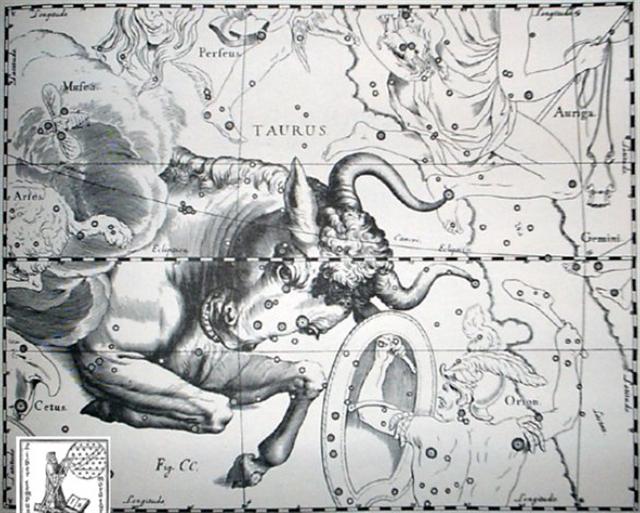I guess the design in Ga1-1 could represent the idea of a door opening up in front (repeated by the arms held high in the following tagata:and by the open mouth of the rising Aldebaran fish):
And the pair of figures in Ga1-6
could indicate a past with
growing darkness at left and clear
nights in front. If so, then it would
agree with the old story encoded in
the sky of how the Bull here was
forcing his way through the rain clouds.
Aldebaran could be depicted in
Ga1-4 as a young and lean rising 'fish' with
hungry open
mouth to illustrate life returning
after a harsh winter -
north of the equator and once upon a
time. Antares would at that time
have been close to the Full Moon, but
the G text seems to focus on
heliacal Aldebaran. This can be
deduced from my worked out position of
heliacal Polaris:
72 * 5 = 360 indicates the final of the old year. Ignoring the decimal point 414 could be interpreted as 1 more than 413 (= 14 * 29½). Furthermore, 41.4 quite possibly alludes to Bharani at RA 41.4, from where Aldebaran (the Follower) might have originated (148 - 121 = 27 days earlier):
The difference 68.2 - 41.4 = 26.8 reminds us of the distance from Cb1-10 to Cb12-4:
116 = 4 * 29 and 4 * 117 = 468 = 39 * 12. And 384 = 32 * 12 and 42 * 6 (4-26, April 26) = 252 = 21 * 12. Anyhow, from April 17 to May 27 (where 52 * 7 = 364) there were 147 - 107 = 40 days. And 364 - 40 = 324 (= 116 + 208 = 4 * 29 + 8 * 26). ... Under Mosaic law, a mother who had given birth to a man-child was considered unclean for seven days; moreover she was to remain for three and thirty days 'in the blood of her purification', which makes a total of 40 days ... And from Bharani to Aldebaran there were 27 days, i.e. the same distance as that from March 21 (80) to April 17 (107):
This suggests a structure based on 27 nights between stars at 0h and their 'followers'. If this idea proves correct, then the difference between the heliacal calendar and the nakshatra calendar from the time of Al Sharatain (discovered in the C text) may have been a structure 'inherited' from way back in time:
"April 13 was a date (4-13) which alluded to 14 * 29½. "April 14, the next day, was the first of the next cycle and 104 = 2 * 52. '[Sahagun:] ... When it was evident that the years lay ready to burst into life, everyone took hold of them, so that once more would start forth - once again - another (period of) fifty-two years. Then (the two cycles) might proceed to reach one hundred and four years. It was called 'One Age' when twice they had made the round, when twice the times of binding the years had come together. Behold what was done when the years were bound - when was reached the time when they were to draw the new fire, when now its count was accomplished. First they put out fires everywhere in the country round. And the statues, hewn in either wood or stone, kept in each man's home and regarded as gods, were all cast into the water. Also (were) these (cast away) - the pestles and the (three) hearth stones (upon which the cooking pots rested); and everywhere there was much sweeping - there was sweeping very clear. Rubbish was thrown out; none lay in any of the houses ... "April 15 was day 105 + 366 = 471 counted from "January 1 the preceeding year and equal to the number of glyphs of the tablet. My nakshatra dates at the time of Bharani have numbers which (easily perceived by my colour scheme) agrees with the heliacal dates. "October 17 was 210 days after 0h and twice 21(0) = 42(0): ... The four bereaved and searching divinities, the two mothers and their two sons, were joined by a fifth, the moon-god Thoth (who appears sometimes in the form of an ibis-headed scribe, at other times in the form of a baboon), and together they found all of Osiris save his genital member, which had been swallowed by a fish. They tightly swathed the broken body in linen bandages, and when they performed over it the rites that thereafter were to be continued in Egypt in the ceremonial burial of kings, Isis fanned the corpse with her wings and Osiris revived, to become the rule of the dead. He now sits majestically in the underworld, in the Hall of the Two Truths, assisted by forty-two assessors, one from each of the principal districts of Egypt; and there he judges the souls of the dead. These confess before him, and when their hearts have been weighed in a balance against a feather, receive, according to their lives, the reward of virtue and the punishment of sin.
I conclude the dates from the time of Bharani must be added to my presentations of the G text. Therefore I have adjusted accordingly and also updated my preliminary commentary text. | |||||||||||||||||||||||||||||||||||||||||||||||||||||||||||||||||||||||||||||||||||||||||||||||||||||||||||||||||||||||||||||||||||||||||||||||||||||||||||||||||||||||||||||||||||||||||||||||||||||||||||||||||||||||||||||||||||||






